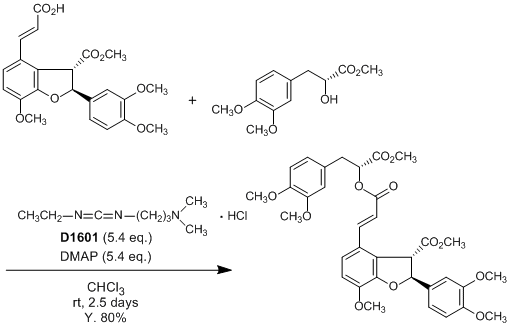Maximum quantity allowed is 999
CAS RN: 25952-53-8 | Product Number: D1601
1-(3-Dimethylaminopropyl)-3-ethylcarbodiimide Hydrochloride [Coupling Agent for Peptides Synthesis]
![1-(3-Dimethylaminopropyl)-3-ethylcarbodiimide Hydrochloride [Coupling Agent for Peptides Synthesis] No-Image](/medias/D1601.jpg?context=bWFzdGVyfHJvb3R8MzY1MzJ8aW1hZ2UvanBlZ3xhR00wTDJnME9DODRPVEl4TURVME5URXhNVE0wTDBReE5qQXhMbXB3Wnd8ZDQ1N2ExZWJmNWJjMTI0NDY1NjU2MWEyYWNkNzVhYTlmZGRlMGJhNDYzYWMzMDU3MmM0MzM0YmIwY2YxYWI0OA)
Purity: >98.0%(T)
- 1-Ethyl-3-(3-dimethylaminopropyl)carbodiimide Hydrochloride
- EDC·HCl
- EDAC·HCl
- EDCI·HCl
* Please contact our distributors or
TCI
to order our products. The above prices do not include freight cost, customs, and other charges to the destination.
* The storage conditions are subject to change without notice.
| Product Number | D1601 |
| Purity / Analysis Method | >98.0%(T) |
| Molecular Formula / Molecular Weight | C__8H__1__7N__3·HCl = 191.70 |
| Physical State (20 deg.C) | Solid |
| Storage Temperature | Refrigerated (0-10°C) |
| Store Under Inert Gas | Store under inert gas |
| Condition to Avoid | Moisture Sensitive,Heat Sensitive |
| CAS RN | 25952-53-8 |
| Reaxys Registry Number | 5764110 |
| PubChem Substance ID | 87568083 |
| SDBS (AIST Spectral DB) | 21309 |
| MDL Number | MFCD00012503 |
| Appearance | White powder to crystal |
| Purity(with Total Nitrogen) | min. 97.0 % |
| Purity(Argentometric Titration) | min. 98.0 % |
| NMR | confirm to structure |
| Melting Point | 116 °C |
| Degree of solubility in water | 1,000 g/l 20 °C |
| Solubility (soluble in) | Dimethylformamide, Alcohol |
| Pictogram |



|
| Signal Word | Danger |
| Hazard Statements | H311 : Toxic in contact with skin. H302 : Harmful if swallowed. H315 : Causes skin irritation. H319 : Causes serious eye irritation. H373 : May cause damage to organs through prolonged or repeated exposure. H317 : May cause an allergic skin reaction. H410 : Very toxic to aquatic life with long lasting effects. |
| Precautionary Statements | P501 : Dispose of contents/ container to an approved waste disposal plant. P273 : Avoid release to the environment. P272 : Contaminated work clothing should not be allowed out of the workplace. P260 : Do not breathe dust/ fume/ gas/ mist/ vapors/ spray. P270 : Do not eat, drink or smoke when using this product. P264 : Wash skin thoroughly after handling. P280 : Wear protective gloves/ protective clothing/ eye protection/ face protection. P391 : Collect spillage. P314 : Get medical advice/ attention if you feel unwell. P337 + P313 : If eye irritation persists: Get medical advice/ attention. P305 + P351 + P338 : IF IN EYES: Rinse cautiously with water for several minutes. Remove contact lenses, if present and easy to do. Continue rinsing. P361 + P364 : Take off immediately all contaminated clothing and wash it before reuse. P333 + P313 : If skin irritation or rash occurs: Get medical advice/ attention. P301 + P312 + P330 : IF SWALLOWED: Call a POISON CENTER/doctor if you feel unwell. Rinse mouth. P302 + P352 + P312 : IF ON SKIN: Wash with plenty of water.Call a POISON CENTER/doctor if you feel unwell. P405 : Store locked up. |
| RTECS# | FF2200000 |
| UN Number | UN2811 |
| Class | 6.1 |
| Packing Group | III |
| H.S.code* | 2925.29-000 |
-
Used Chemicals
-
Procedure
-
1-(2-methoxyphenyl)piperazine (500 mg, 2.60 mmol) was dissolved in DMF (15 mL). To this solution was added N-benzyloxycarbonyl-L-phenylalanine (770 mg, 2.60 mmol) and HOBt·H2O (414 mg, 2.71 mmol). The reaction mixture was cooled to 0 °C, then EDC·HCl (515 mg, 2.71 mmol) was added. Reaction was allowed to warm to room temperature, then stirred for 20 h at room temperature. Complete of the reaction was confirmed by TLC. Reaction was quenched by adding H2O (20 mL). Reaction mixture was extracted by EtOAc (30 mL). Organic phase was washed with H2O (20 mL, twice) and brine (20 mL), dried over Na2SO4, concentrated under reduced pressure to afford the crude product (1.2 g) as pale yellow oil. The crude product was purified by column chromatography on silica gel (hexane : ethyl acetate = 40 : 60) to afford the product 1 as a white powder (1.10 g, 2.32 mmol, 90%).
-
Experimenter's Comments
-
The reaction mixture was monitored by TLC (hexane / ethyl acetate = 4 : 6, Rf = 0.40)
-
Analytical Data(Compound 1)
-
1H NMR (400 MHz, CDCl3); δ 7.39-7.16 (m, 10H), 6.99 (m, 1H), 6.91-6.84 (m, 2H), 6.78 (m, 1H), 5.73 (d, J = 8,2 Hz, 1H), 5.12-5.01 (m, 2H), 4.91 (dd, J= 7.7, 7.3 Hz, 1H), 3.82 (s, 3H), 3.71-3.63 (m, 2H), 3.51 (m, 1H), 3.31 (m, 1H), 3.07-2.78 (m, 5H), 2.51 (m, 1H).

(Δ means dehydro-form.)
References
- Dehydro‐enkephalins
- Total Synthesis of (+)-Lithospermic Acid by Asymmetric Intramolecular Alkylation via Catalytic C−H Bond Activation

References
Articles/Brochures
Safety Data Sheet (SDS)
The requested SDS is not available.
Please Contact Us for more information.
Specifications
C of A & Other Certificates
Sample C of A
A sample C of A for this product is not available at this time.
Analytical Charts
The requested analytical chart is not available. Sorry for the inconvenience.

![1-(3-Dimethylaminopropyl)-3-ethylcarbodiimide Hydrochloride [Coupling Agent for Peptides Synthesis] 1-(3-Dimethylaminopropyl)-3-ethylcarbodiimide Hydrochloride [Coupling Agent for Peptides Synthesis]](/_ui/responsive/theme-tci/images/missing_product_zoom.jpg)


